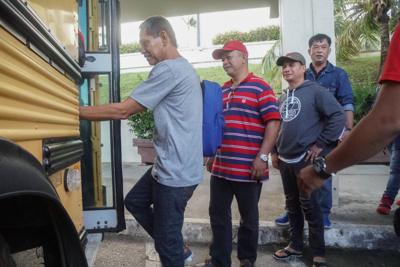The U.S. Department of Homeland Security, in consultation with the State Department, announced over the weekend that workers from the Philippines are no longer allowed to seek employment in the United States under H-2B and H-2A work visas.
Guam's main source of foreign labor for decades has been the Philippines.
DHS's notice on the ban on workers from the Philippines went into effect Jan. 19, the department stated in a notice on the Federal Register.
It continues for a year.
H-2B visas have been the path to bringing in workers from the Philippines for construction jobs and for certain workers in the health care field. H-2A visas are for agricultural workers.
The change was prompted by what DHS called a high rate of Filipino workers' "overstay" – meaning workers don't return to the Philippines when the time allowed for them to work in the United States expires.
In the 2017 budget year, "DHS estimated that nearly 40 percent of H-2B visa holders from the Philippines overstayed their period of authorized stay," Homeland Security added.
Homeland Security and the State Department also stated their concern about the high volume of human "trafficking victims from the Philippines – who were originally issued H-2B visas – and the potential that continued H-2B visa issuance may encourage or serve as an avenue for future human trafficking from the Philippines."
"These overstay and human trafficking concerns are severe enough to warrant removal from the H-2A visa program as well," Homeland Security's notice states.
The Philippines has shown a four-fold increase in H-2A visa applications during the 2015 to 2018 budget years, Homeland Security stated.
"The Philippines' continued inclusion creates the potential for abuse, fraud and other harm to the integrity of the H-2A or H-2B visa programs."
Two other countries – Ethiopia and the Dominican Republic – are included in DHS's latest ban.
Sen. Régine Biscoe Lee, chairperson of the 35th Guam Legislature's Committee on Federal Affairs, stated: "We are all working together to fully understand the impact of this new rule on our economy and our way of life. The truth is that Guam has relied on skilled labor from the Philipines for decades. And we are better and stronger as a community because of it."
While the new rule does not bar all H-2s, and does provide for exemptions tied to national defense, this means that a bureaucratic decision in Washington, D.C., will determine the cost of home construction or the availability of skilled nurses at our hospitals and clinics," Biscoe Lee stated.
"I'm a Marine wife, and I love this country, but this isn't fair to an island that has given so much life and land in the service of American freedom."
Current visa holders not affected; status remains
The ban does not affect the status of workers who currently hold valid H-2A or H-2B nonimmigrant status unless they either seek an extension of stay or change their visa status, states the notice signed by DHS Secretary Kirstjen Nielsen.
Jenn Davis, an immigration attorney representing certain Guam employers, stated this notice does apply to Guam military buildup projects, including the projects under the National Defense Authorization Act.
However, the notice includes a possible exception for NDAA projects, she stated.
USCIS can approve H-2B petitions for beneficiaries from non-designated countries if USCIS determines – "based on the totality of the circumstances" – that it is in the U.S. interest for the individual to be a beneficiary of an H-2B petition. The notice identifies Guam's NDAA provision as an example of such national interest, Davis stated
However, this exception is applied at U.S. Citizenship of Immigration Services' discretion and on a case-by-case basis.
"The vast majority of Guam H-2B workers come from the Philippines, so this new rule adds yet another hurdle for Guam contractors to overcome," Davis stated. "We are already facing unprecedented challenges in getting the labor we need for both military and nonmilitary construction projects. Now, that challenge is even greater."
A USCIS policy memorandum in October 2018 states USCIS will determine whether the petitioner for an H-2 worker has met its burden of demonstrating eligibility under the NDAA based on the totality of the evidence.
A previous major source of H-2B labor for Guam – China – was delisted from the H-2 visa program by the U.S. government years ago.
What countries can provide H-2 labor
In its Jan. 19 notice, DHS announced it added Samoa back onto the list of H-2A- and H-2B-eligible countries because Samoa was no longer "at-risk" for overstays.
Eighty-one countries are still approved for the H-2 visa program.
They are: Andorra, Argentina, Australia, Austria, Barbados, Belgium, Brazil, Brunei, Bulgaria, Canada, Chile, Colombia, Costa Rica, Croatia, Czech Republic, Denmark, Ecuador, El Salvador, Estonia, Fiji, Finland, France, Germany, Greece, Grenada, Guatemala, Honduras, Hungary, Iceland, Ireland, Israel, Italy, Jamaica, Japan, Kiribati, Latvia, Lichtenstein, Lithuania, Luxembourg, Macedonia, Madagascar, Malta, Mexico, Monaco, Mongolia, Montenegro, Mozambique, Nauru, the Netherlands, New Zealand, Nicaragua, Norway, Panama, Papua New Guinea, Peru, Poland, Portugal, Romania, Samoa, San Marino, Serbia, Singapore, Slovakia, Slovenia, Solomon Islands, South Africa, South Korea, Spain, St. Vincent and the Grenadines, Sweden, Switzerland, Taiwan, Thailand, Timor-Leste, Tonga, Turkey, Tuvalu, Ukraine, United Kingdom, Uruguay and Vanuatu.


